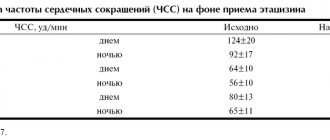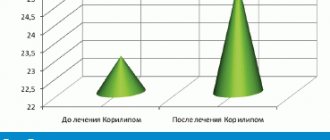Verospilactone, 20 pcs., 25 mg, tablets
Inside.
For essential hypertension
The daily dose for adults is usually 50-100 mg once and can be increased to 200 mg, and the dose should be increased gradually, once every 2 weeks. To achieve an adequate response to therapy, the drug must be taken for at least 2 weeks. If necessary, adjust the dose.
For idiopathic hyperaldosteronism, 100–400 mg/day.
For severe hyperaldosteronism and hypokalemia, 300 mg/day (maximum 400 mg) in 2–3 doses; as the condition improves, the dose is gradually reduced to 25 mg/day.
Hypokalemia/hypomagnesemia
For hypokalemia and/or hypomagnesemia caused by diuretic therapy, the drug is prescribed at a dose of 25–100 mg/day, once or in several doses. The maximum daily dose is 400 mg if oral potassium supplements or other methods of replenishing the deficiency are ineffective.
Diagnosis and treatment of primary hyperaldosteronism
As a diagnostic tool for a short diagnostic test:
for 4 days, 400 mg/day, divided into several doses per day. If the concentration of potassium in the blood increases while taking the drug and decreases after its discontinuation, the presence of primary hyperaldosteronism can be assumed.
For a long-term diagnostic test:
at the same dose for 3–4 weeks. When correction of hypokalemia and arterial hypertension is achieved, the presence of primary hyperaldosteronism can be assumed.
Short course of preoperative therapy for primary hyperaldosteronism
After the diagnosis of hyperaldosteronism has been established using more accurate diagnostic methods, Verospilactone should be taken at a dose of 100–400 mg/day, divided into 1–4 doses per day during the entire period of preparation for surgery. If surgery is not indicated, then Verospilactone is used for long-term maintenance therapy, using the lowest effective dose, which is selected individually for each patient.
Edema due to nephrotic syndrome
The daily dose for adults is usually 100–200 mg/day. No effect of Verospilactone on the underlying pathological process has been identified, and therefore the use of this drug is recommended only in cases where other types of therapy are ineffective.
For edema syndrome against the background of chronic heart failure, daily, for 5 days, 100–200 mg/day in 2–3 doses, in combination with a loop or thiazide diuretic. Depending on the effect, the daily dose is reduced to 25 mg. The maintenance dose is selected individually. Maximum dose 200 mg/day.
Edema due to liver cirrhosis
If the ratio of sodium and potassium ions (Na+/K+) in the urine exceeds 1.0, then the daily dose for adults is usually 100 mg. If the ratio is less than 1.0, then the daily dose for adults is usually 200–400 mg. The maintenance dose is selected individually.
Edema in children
The initial dose is 1–3.3 mg/kg body weight or 30–90 mg/m2/day. In 1–4 doses. After 5 days, the dose is adjusted and, if necessary, increased by 3 times compared to the original.
Verospilactone, 100 mg, capsules, 30 pcs.
Inside.
Essential hypertension
The daily dose for adults is usually 50-100 mg once and can be increased to 200 mg, and the dose should be increased gradually, once every 2 weeks. To achieve an adequate response to therapy, the drug must be taken for at least 2 weeks. If necessary, adjust the dose.
Idiopathic hyperaldosteronism
Prescribe 100–400 mg/day.
Severe hyperaldosteronism and hypokalemia
Prescribe 300 mg/day (maximum 400 mg/day) in 2–3 doses; as the condition improves, the dose is gradually reduced to 25 mg/day.
Hypokalemia and/or hypomagnesemia
For hypokalemia and/or hypomagnesemia caused by diuretic therapy, the drug is prescribed at a dose of 25–100 mg/day, once or in several doses. The maximum daily dose is 400 mg if oral potassium supplements or other methods of replenishing the deficiency are ineffective.
Diagnosis and treatment of primary hyperaldosteronism
As a diagnostic tool for a short diagnostic test:
for 4 days, 400 mg/day, divided into several doses per day. If the concentration of potassium in the blood increases while taking the drug and decreases after its discontinuation, the presence of primary hyperaldosteronism can be assumed.
For a long-term diagnostic test:
at the same dose for 3–4 weeks. When correction of hypokalemia and arterial hypertension is achieved, the presence of primary hyperaldosteronism can be assumed.
Short course of preoperative therapy for primary hyperaldosteronism
After the diagnosis of hyperaldosteronism has been established using more accurate diagnostic methods, Verospilactone® should be taken at a dose of 100–400 mg/day, divided into 1–4 doses per day during the entire period of preparation for surgery. If surgery is not indicated, then the drug Verospilactone® is used for long-term maintenance therapy, using the lowest effective dose, which is selected individually for each patient.
Edema due to nephrotic syndrome
The daily dose for adults is usually 100–200 mg/day. No effect of spironolactone on the underlying pathological process has been identified, and therefore the use of this drug is recommended only in cases where other types of therapy are ineffective.
Edema syndrome due to chronic heart failure
Daily, for 5 days, 100–200 mg/day in 2–3 divided doses, in combination with a loop or thiazide diuretic. Depending on the effect, the daily dose is reduced to 25 mg. The maintenance dose is selected individually. Maximum dose 200 mg/day.
Edema due to liver cirrhosis
If the ratio of sodium and potassium ions (Na+/K+) in the urine exceeds 1.0, then the daily dose for adults is usually 100 mg. If the ratio is less than 1.0, then the daily dose for adults is usually 200–400 mg. The maintenance dose is selected individually.
Edema in children
The initial dose in children over 3 years of age is 1–3.3 mg/kg body weight or 30–90 mg/m2/day. In 1–4 doses. After 5 days, the dose is adjusted and, if necessary, increased by 3 times compared to the original.
Side effects
In some cases, taking a medication can lead to side effects from different organ systems:
- gastritis;
- constipation;
- abdominal pain, colic;
- liver disorders;
- vomit;
- headache;
- dizziness;
- confusion;
- increased drowsiness;
- muscle spasm;
- allergies (rash, hives, itching);
- alopecia;
- problems with potency;
- acidosis.
Verospilactone
Verospilactone (international nonproprietary name - spironolactone) is a domestically produced potassium-sparing diuretic. Today, it has been reliably established that the main contribution to the overall pharmacological effect of drugs based on spironolactone is made by the active metabolite of this substance formed in the liver - canreonate (hereinafter, spironolactone will be understood, for the most part, as it is). Penetrating into the cell, spironolactone interacts with mineralocorticoid receptors, preventing aldosterone from doing the same. The resulting complex is inactive, and therefore the production of permease in the renal tubular cells stops, which inactivates Na+/K+-ATPase and suppresses the reabsorption (reabsorption) of sodium ions from urine. Stopping sodium reabsorption reduces the negative potential on the outer surface of cell membranes, which in turn suppresses the secretion of potassium ions into the urine. In addition, spironolactone blocks the activity of enzymes involved in the synthesis of aldosterone, which reduces the concentration of the latter in the body and also helps to reduce the reabsorption of sodium ions and the secretion of potassium ions.
Verospilactone is well absorbed in the gastrointestinal tract (90%), which, however, is partially neutralized by hepatic first-pass metabolism, inactivating from 30 to 70% of the active substance. That is why verospilactone, as well as other spironolactone preparations, is recommended to be taken after meals to slow down their inactivation. Despite the fact that verospilactone belongs to the group of diuretics, its diuretic effect is very modest, which is explained by the place of application of the drug’s forces: the collecting ducts of the kidneys, the contribution of which to sodium reabsorption is insignificant. Increased diuresis during the action of the drug develops slowly - over 2-5 days. After discontinuation of verospilactone, the diuretic effect persists for another 2-3 days.
It is characteristic that the condition for the manifestation of the diuretic effect of the drug is the presence of a sufficient level of aldosterone. Otherwise, the activity of permease in the collecting ducts will initially be low, which will not allow veroshpilactone to fully demonstrate its diuretic “talents”. The antihypertensive effect of the drug can only be discussed if high doses (more than 100 mg per day) are taken. However, it should be taken into account that in this case negative side reactions will also manifest themselves more clearly. Another effect of verospilactone is antiandrogenic: the drug weakens the effect of male sex hormones on the human body.
The main field of action for verospilactone is primary and secondary hyperaldosteronism. The latter is often observed, for example, in chronic heart failure or cirrhosis of the liver. The drug can also be used to prevent the development of hypokalemia in cases where the patient is taking potassium-removing (loop or thiazide) diuretics. Verospilactone is available in tablets and capsules. The dosage regimen is set individually, taking into account the degree of water-electrolyte imbalance and hormonal disorders. For edematous syndrome, the drug is prescribed 100-200 mg per day for 2-3 doses. The duration of treatment is 2-3 weeks with the possibility of periodically repeating drug courses with breaks of 10-14 days between them. Based on the values of potassium concentration in the blood, further dose adjustments are made. In case of atrioventricular blockade, the drug should be used with extreme caution, because against the background of hyperkalemia, this condition may worsen further. During pharmacotherapy with verospilactone, it is recommended to periodically check the plasma levels of electrolytes and urea. When combining the drug with other diuretics (or other groups of antihypertensive drugs), the dose of the latter should be reduced.
Verospilactone, 50 mg, capsules, 30 pcs.
Inside.
Essential hypertension
The daily dose for adults is usually 50-100 mg once and can be increased to 200 mg, and the dose should be increased gradually, once every 2 weeks. To achieve an adequate response to therapy, the drug must be taken for at least 2 weeks. If necessary, adjust the dose.
Idiopathic hyperaldosteronism
Prescribe 100–400 mg/day.
Severe hyperaldosteronism and hypokalemia
Prescribe 300 mg/day (maximum 400 mg/day) in 2–3 doses; as the condition improves, the dose is gradually reduced to 25 mg/day.
Hypokalemia and/or hypomagnesemia
For hypokalemia and/or hypomagnesemia caused by diuretic therapy, the drug is prescribed at a dose of 25–100 mg/day, once or in several doses. The maximum daily dose is 400 mg if oral potassium supplements or other methods of replenishing the deficiency are ineffective.
Diagnosis and treatment of primary hyperaldosteronism
As a diagnostic tool for a short diagnostic test:
for 4 days, 400 mg/day, divided into several doses per day. If the concentration of potassium in the blood increases while taking the drug and decreases after its discontinuation, the presence of primary hyperaldosteronism can be assumed.
For a long-term diagnostic test:
at the same dose for 3–4 weeks. When correction of hypokalemia and arterial hypertension is achieved, the presence of primary hyperaldosteronism can be assumed.
Short course of preoperative therapy for primary hyperaldosteronism
After the diagnosis of hyperaldosteronism has been established using more accurate diagnostic methods, Verospilactone® should be taken at a dose of 100–400 mg/day, divided into 1–4 doses per day during the entire period of preparation for surgery. If surgery is not indicated, then the drug Verospilactone® is used for long-term maintenance therapy, using the lowest effective dose, which is selected individually for each patient.
Edema due to nephrotic syndrome
The daily dose for adults is usually 100–200 mg/day. No effect of spironolactone on the underlying pathological process has been identified, and therefore the use of this drug is recommended only in cases where other types of therapy are ineffective.
Edema syndrome due to chronic heart failure
Daily, for 5 days, 100–200 mg/day in 2–3 divided doses, in combination with a loop or thiazide diuretic. Depending on the effect, the daily dose is reduced to 25 mg. The maintenance dose is selected individually. Maximum dose 200 mg/day.
Edema due to liver cirrhosis
If the ratio of sodium and potassium ions (Na+/K+) in the urine exceeds 1.0, then the daily dose for adults is usually 100 mg. If the ratio is less than 1.0, then the daily dose for adults is usually 200–400 mg. The maintenance dose is selected individually.
Edema in children
The initial dose in children over 3 years of age is 1–3.3 mg/kg body weight or 30–90 mg/m2/day. In 1–4 doses. After 5 days, the dose is adjusted and, if necessary, increased by 3 times compared to the original.


